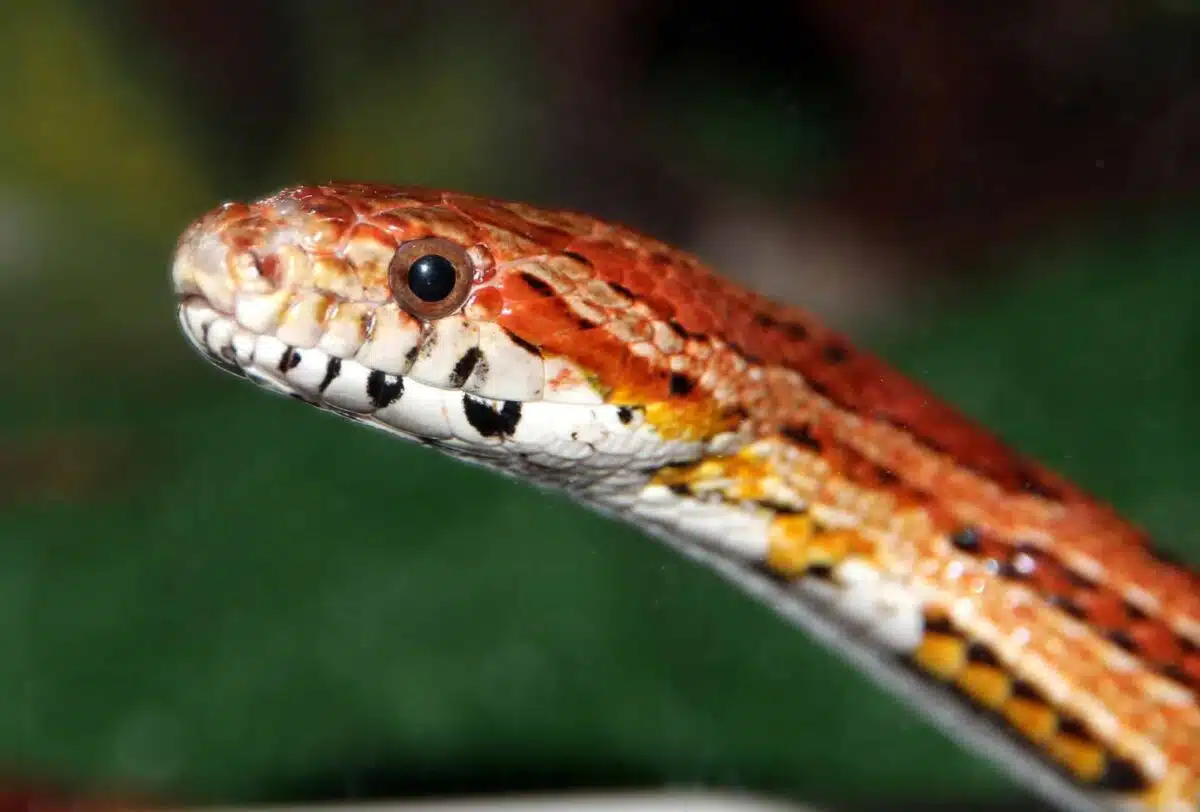Chicken snakes are nonvenomous snakes and have been granted their name because they love to eat chicken. However, they typically consume small animals like birds and rats.
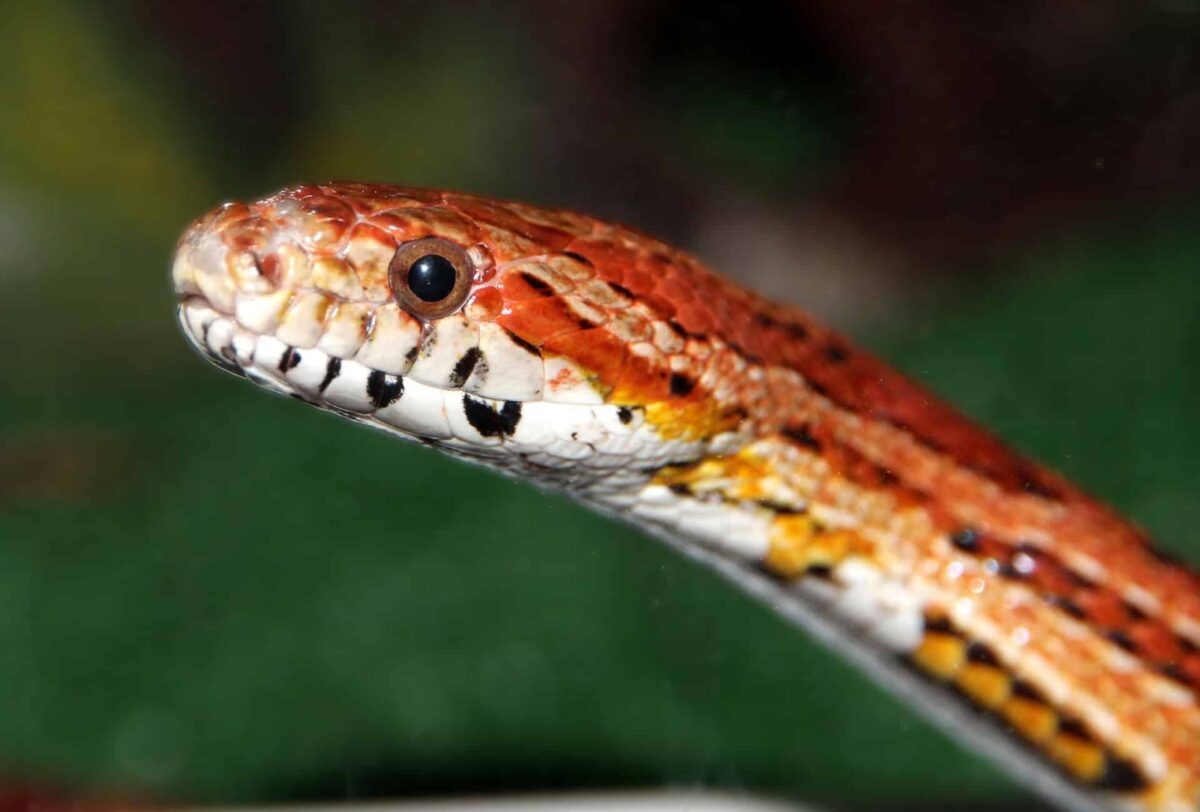
This creepy species is native to North America. They frequently reside close to the water and inhabit forest areas. Moreover, they typically have a brown or gray color and black stripes down their backs.
Usually, these snakes can reach lengths of 2 to 4 feet, although sometimes, they can grow more than seven feet long. This species will choke its prey before eating it. The majority will coil and attack when they sense any threat, but their bite is not poisonous. However, it is still extremely painful.
Chicken Snake Scientific Name
Spilotes pullatus is the scientific name for a chicken snake. Spilotes is derived from “spilos”. It is a Greek word that means “spotted or stained.” The word pullatus is derived from Latin, it implies “wearing dark clothes.” It is given this name because of its appearance.
Classification of Chicken Snakes:
Chicken snakes are not a single species or category of snake. They are made up of five different snake species including:
#1 Eastern Rat Snake:
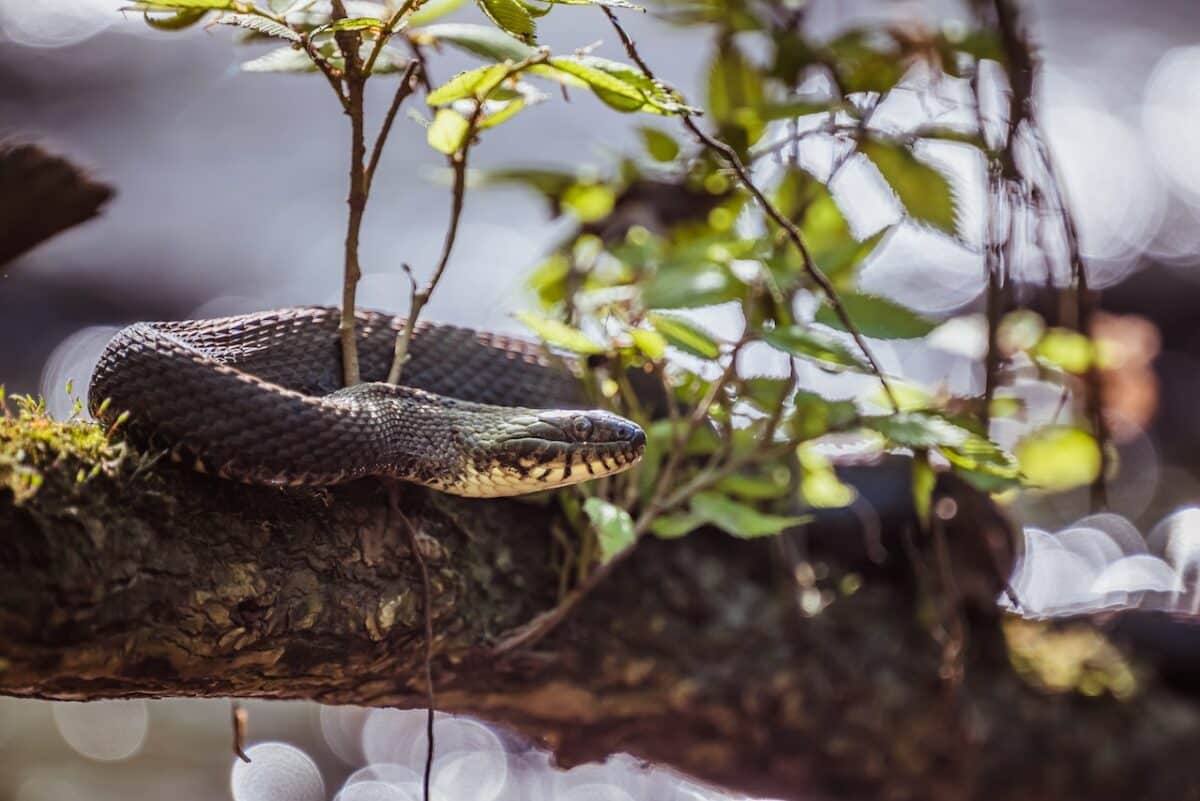
Not poisonous by nature, the eastern rat snake is the largest of the five species. They can reach a length of seven feet. The back has shiny black scales, and the stomach has pale black scales. Their chin region and throat are white. The body is slender, but the head is broad. They can be found across the Midwest, from Connecticut to South Carolina.
#2 Corn Snake:
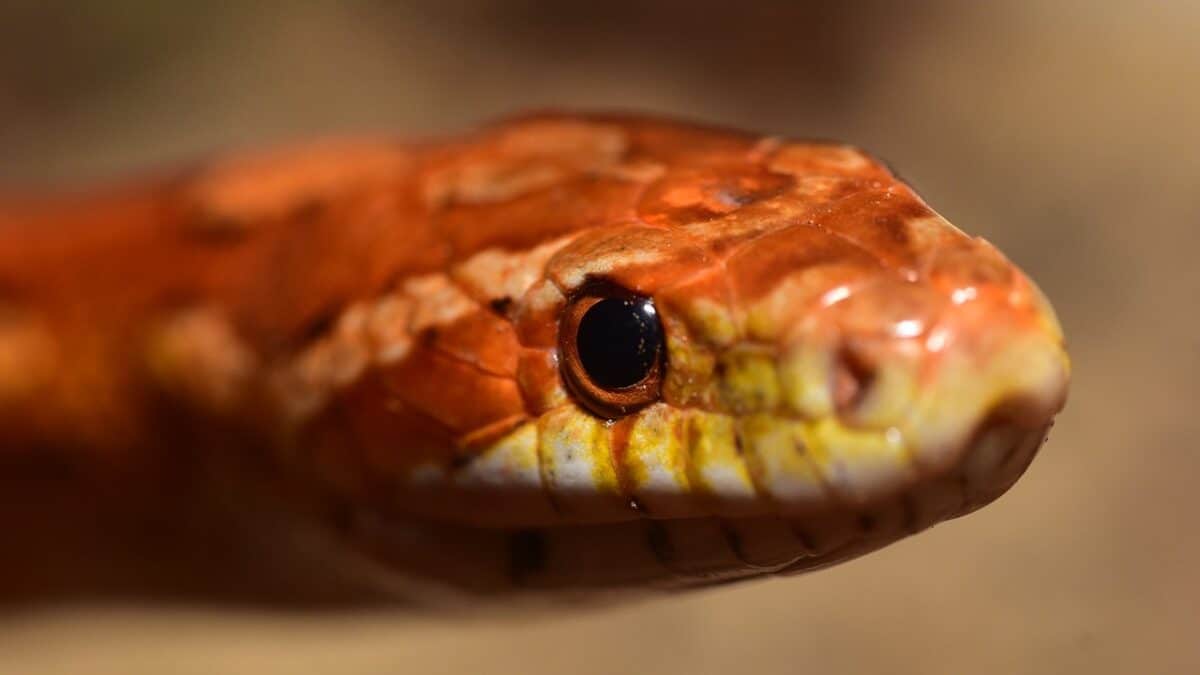
Corn snakes are very small and thin. The majority of individuals are barely two or three feet long. This type och chicken snake is non-venomous.
They have orange, reddish brown, and gray colors, and their scales have a spotted pattern. A single stripe runs from below the eye to the torso.
#3 Black Rat Snake:
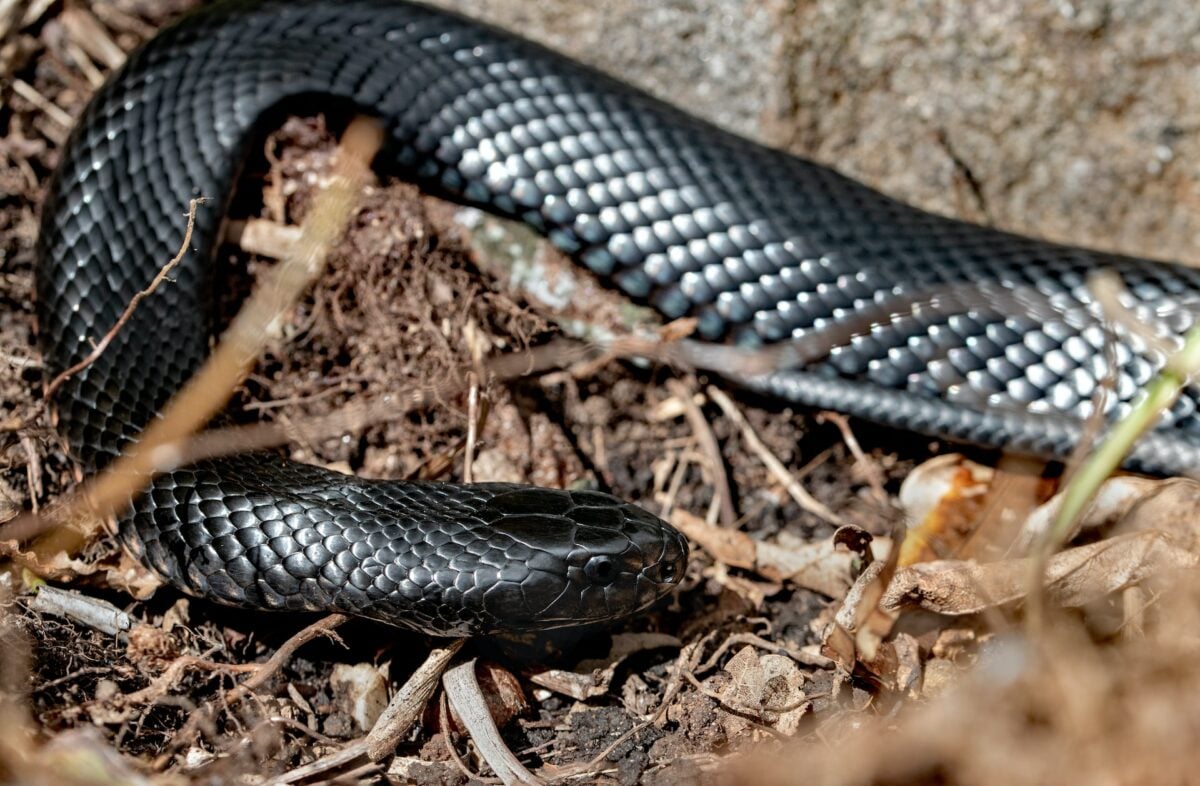
These species are not venomous either. They have a six-foot maximum growth limit. Scales on the belly are brighter and more white-looking, whereas the back is dull and black, and the throat area is whitish. The body is smaller than the head. They are located in the majority of U.S. states from the Midwest to the East.
#4 Gray Rat Snake:
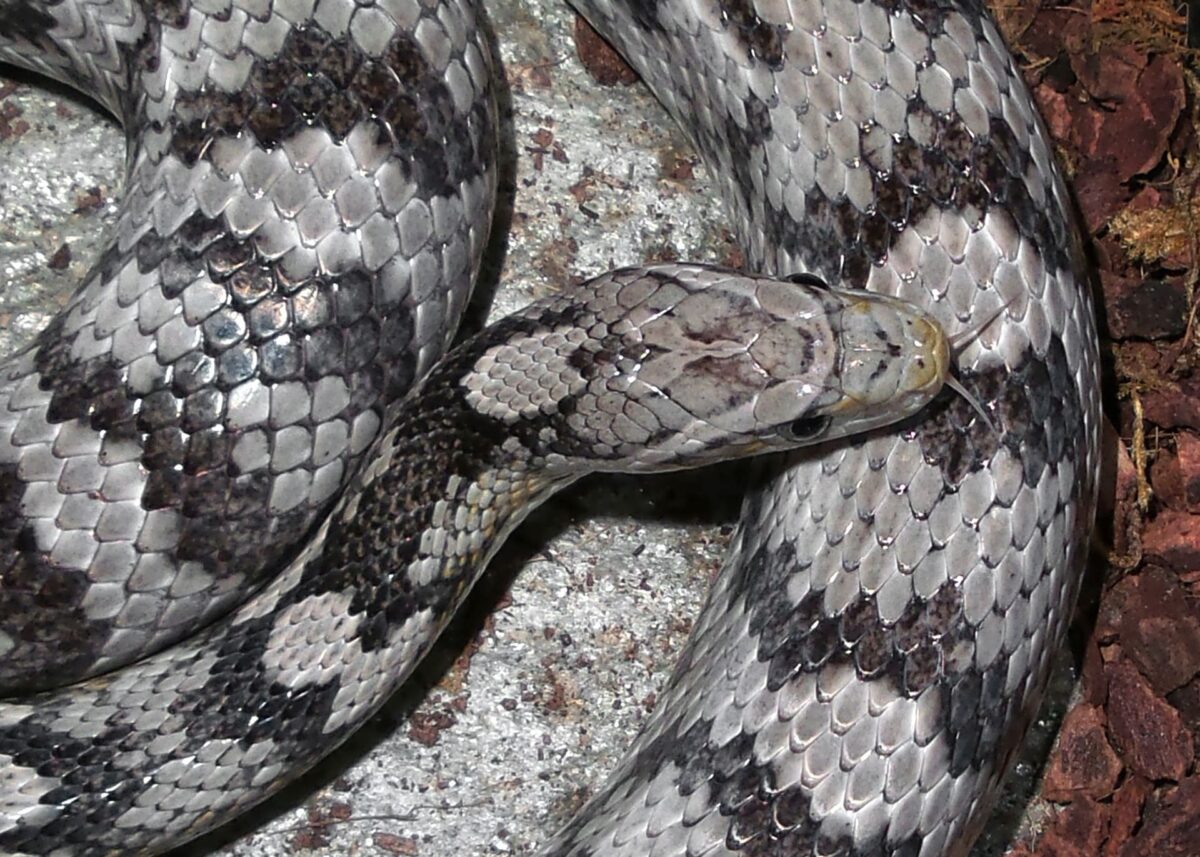
Gray rat snakes do not bite and can reach a length of eight feet. Moreover, they have dark gray markings on the back and are black or dark brown.
The belly has a checkerboard pattern and is either white or dark yellow. Their head is thinner than their body, and they are present throughout the states from the Midwest to the east.
#5 Northern Pine Snake:
Northern Pine snakes are not venomous either. They have a maximum length of eight feet. They have black body splotches that are gray-brown to rusty-brown in color.
The belly can range in color from cream to yellow to tan. Its body is larger than its head, and it has a tortoise-like appearance. They can be found in the eastern portion of the country.
Unique Features of Chicken Snakes:
This snake is long and, at times, extremely long and thin. They have a separate head from their neck, which is often black and yellow. The yellow marks can take the shape of diagonals, nets, or cross bands, depending on the snake’s habitat.
The center of the body has 16 to 14 rows of dorsal scales, whereas the belly contains between 198 and 232 scales. In addition, the underside of the tail has 90 to 120 split scales. It has big eyes and wide pupils, just like many colubrids.
Physical Appearance of Chicken Snakes:
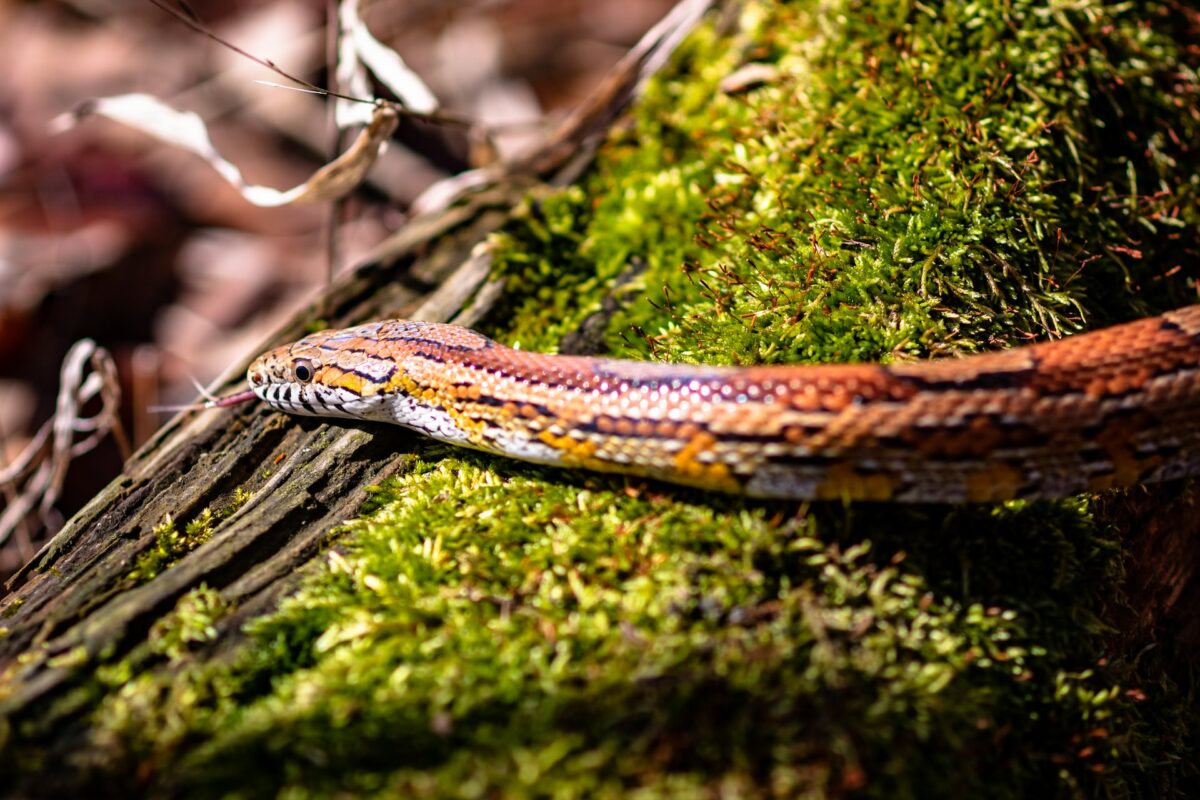
Typically, the bodies of chicken snakes are uniformly brown or tan. Sometimes, they feature light color spots. They have a pattern that is similar to chicken feathers. Additionally, these snakes have prominent dark bands.
These bands run down their backs and around their eyes, making them easier to identify from other kinds of local snakes. Chicken snakes aren’t very dangerous to people. It is because they have very small teeth. They are relatively small in size and hardly ever bite.
Habitat:
Chicken snakes can be found in a range of locations across North America. You can also encounter them in southern Mexico, Central America, northern and central South America, and Trinidad and Tobago. Although they can travel well on the ground, they move well in trees too. Impressive!
They frequently inhabit marshes, swamps, and woodlands. Oftentimes they are discovered on farms as well. Primarily because there are many rodents, their favorite food, chicken snakes may even live inside homes in some situations.
Diet:
Chicken snakes are voracious predators. It implies that they’ll consume whatever meal is available to them. They prefer to hunt small creatures like rodents and birds. However, they can also eat carrion, frogs, eggs, and lizards.
There are certain reported instances of chicken snakes killing chickens. Some chicken snakes have excellent climbing skills, allowing them to navigate quickly between trees. In this way, they can swallow bird eggs from bird nests.
Reproduction and Mating:
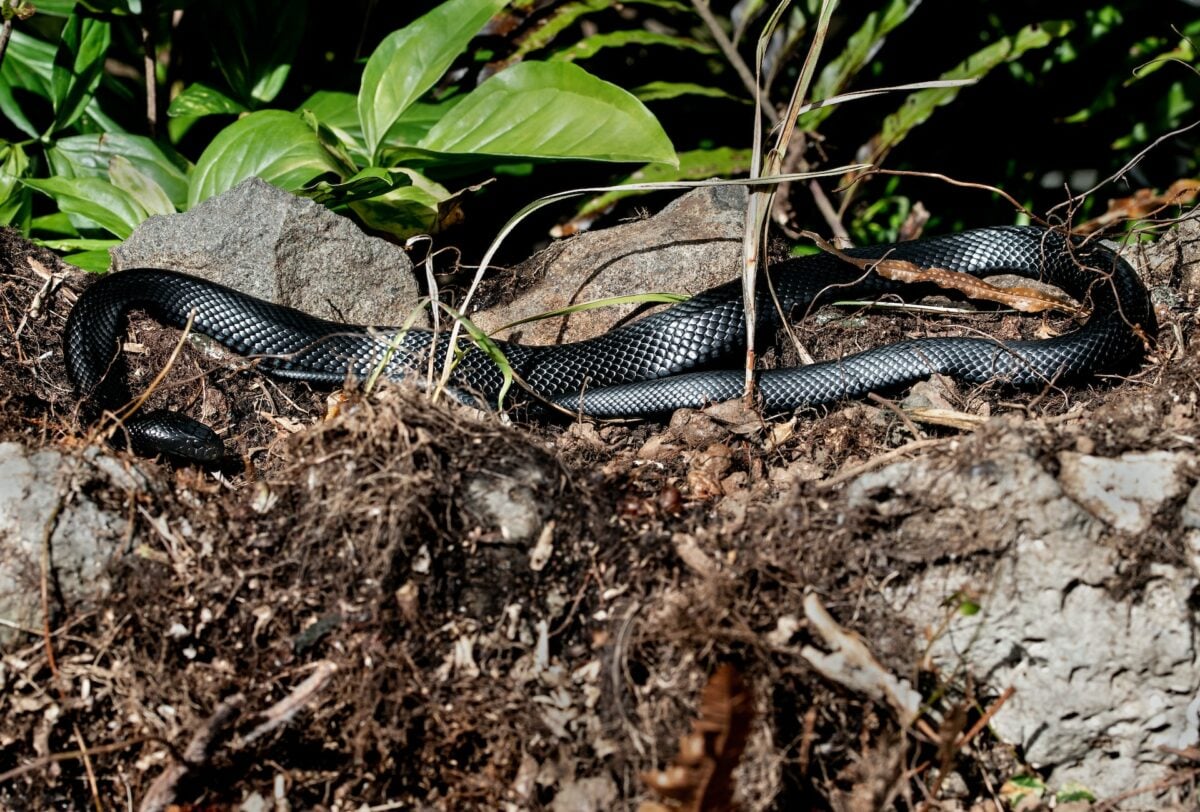
Spring is when the snake’s breeding season begins. The male follows the female in a courtship ritual. After mating, the female deposits 12 to 18 eggs in a secluded area. After 73 to 76 days, baby snakes begin to emerge.
The hatchlings survive on their own unless they become prey to other animals. When a chicken snake hatches, it is between 8 and 12 inches long.
Chicken Snake Behavior:
Chicken snakes are territorial and isolated animals. However, if they feel a threat, they will try to escape. If they are in a tree, they will fall to the ground and try to hide. The swelling of their neck is their most noticeable threat signal – this gives them a cobra-like appearance.
Most chicken snakes are nocturnal animals. In other words, they are mainly active at night. Additionally, they usually hide in holes or beneath rocks during the day. They also rattle their tails, imitating the deadly rattlesnake. If these gestures do not scare a predator, the snake may attack.
When Are Chicken Snakes Active?
Chicken snakes are mainly nocturnal animals. Moreover, when the weather is cool, they are most energetic. However, they might be active in the early morning hours as well. They’ll seek out shadowy or dark areas around your house where they like relaxing and cooling off.
Can Chicken Snakes Climb Walls and Trees?
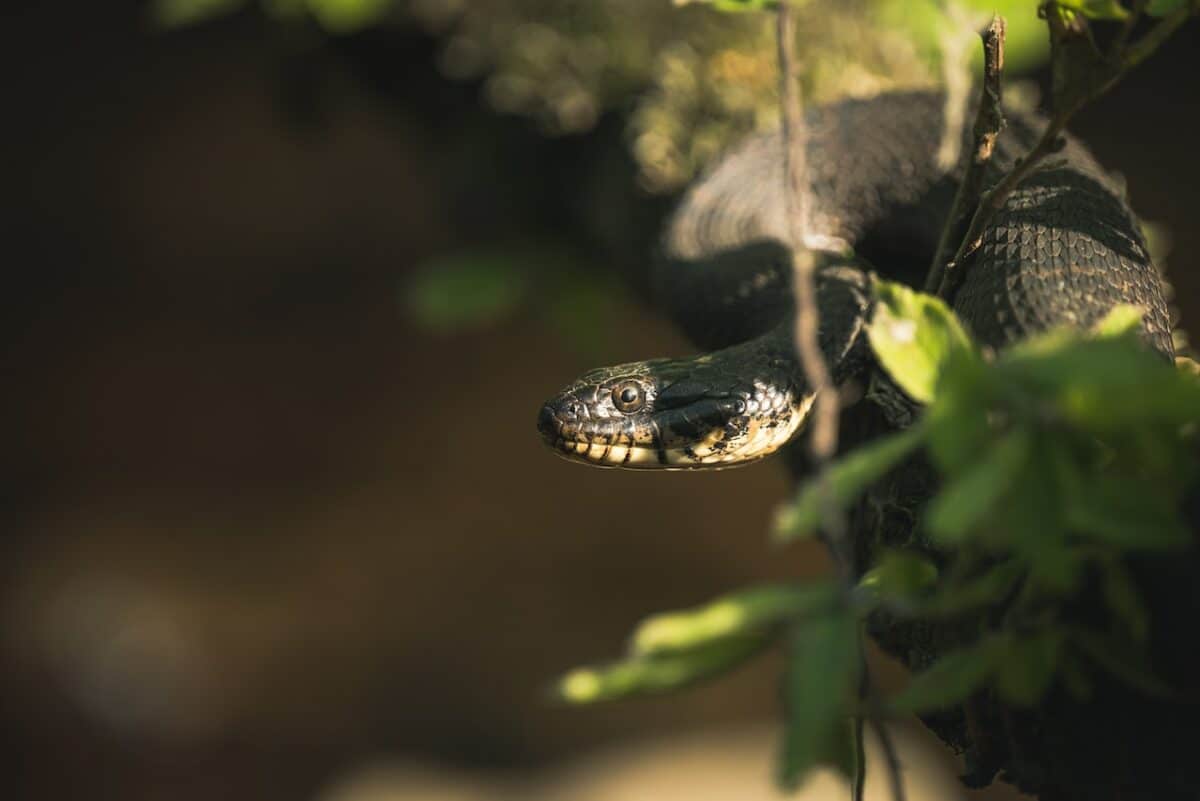
Some chicken snake species are good climbers. They can climb both trees and walls. However, unlike insects, snakes are unable to “stick” to walls. Rather, snakes need a base to push off of and grip onto.
They will sometimes hunt birds in trees. Therefore, they have keeled ventral scales for climbing.
Are Chicken Snakes Poisonous?
Chicken snakes are not poisonous. So, in case they bite, you don’t need to worry. However, they might pass on some poison due to eating other poisonous animals. Therefore, try to avoid interacting with them if you ever encounter them.
What makes Chicken Snakes dangerous?
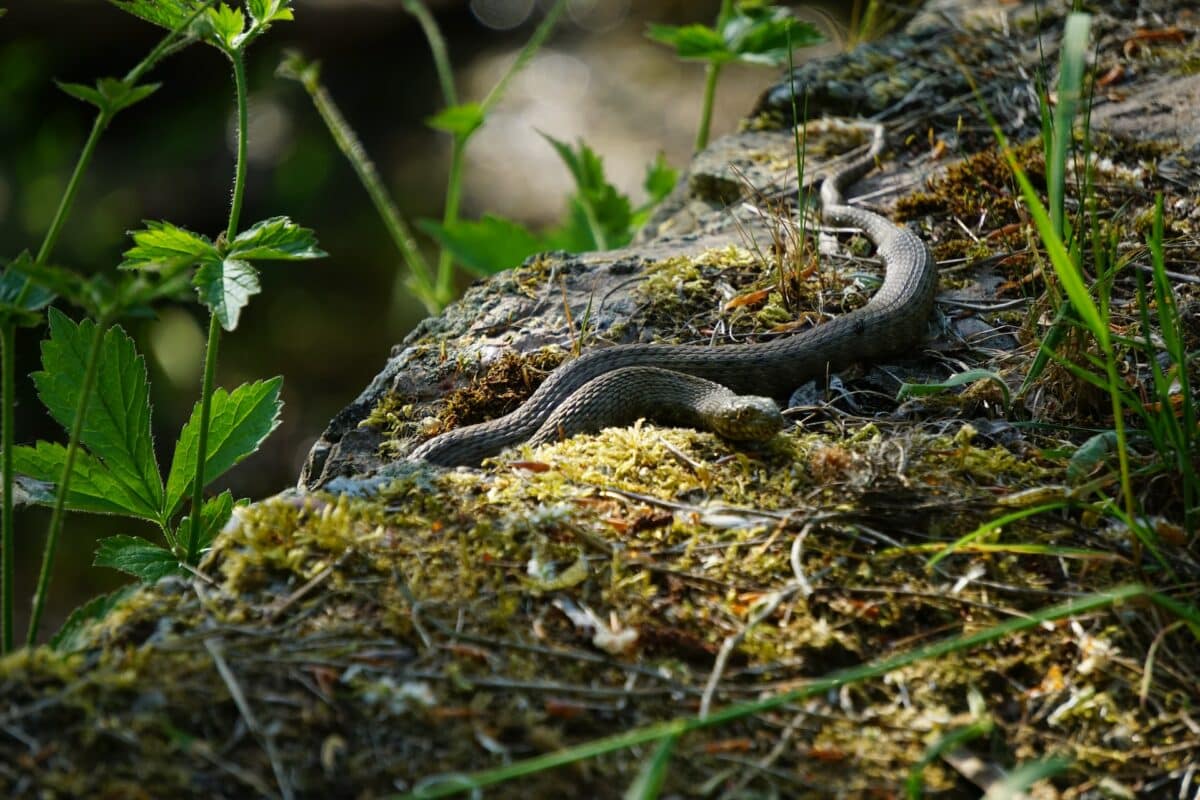
There is no toxic venom in chicken snakes. However, they can still be dangerous to both people and animals. These snakes are constrictors – they encircle and suffocate their prey’s bodies to cause death. Small children or pets may be at risk from this form of hunting.
Chicken snakes may also attack if they sense a threat. They leave an intensely painful open wound behind. However, their bite is not harmful to humans, but should be cleaned and treated just like any other injury.
How Do Chicken Snakes Attack?
Chicken snakes hunt by using their excellent sense of smell to find their prey. They will attack quickly after locating their prey and then constrict the prey until they suffocate.
The snakes squeeze their prey to death. Once the prey dies, the snake can eat it at leisure as they won’t need to worry about it running away.
What Draws Snakes to Your Place?
Food, water supplies, and their preferred prey will attract chicken snakes. They enjoy eating insects, rats, and mice. Thus, their presence can encourage them to come to your home. Moreover, pet food should be kept inside.
Feeding pets indoors keeps snakes and rodents away. It’s because rodents gather near an accessible food source. Pet food will therefore draw rodents if it is left outside, in turn the presence of rodents will attract chicken snakes.
How to Get Rid of Chicken Snakes?
If you see a chicken snake on your premises, you should leave it alone. These snakes help in reducing the number of mice and other tiny rodents. However, they could also endanger the safety of your family or pets.
The best course of action is to contact an expert. They are accustomed to handling these creatures and will carefully remove the snake from your area. Additionally, they will move it to a more suitable habitat.
Learn more on How To Get Rid Of Snakes
1. Be Cautious While Dealing With Them:
You can also manage to remove a chicken snake on your own. However, this is only advised if you have prior experience with these animals. If you decide to handle the snake yourself, use extreme caution.
Put on the appropriate safety gear, like gloves and a long stick. Chicken snakes can become aggressive when trapped. Therefore, it’s necessary to be prepared in case the snake decides to bite.
2. Use Smell That Snakes Hate:
Snakes have an aversion to several specific scents, making them effective natural repellents. These scents include smoke, lime, onions, garlic, cinnamon, and cloves, which are often available in the form of oils and sprays.
Another proactive approach to deter snakes is to cultivate plants that emit these odors. By doing so, you can create a natural barrier to keep these reptiles at bay.
3. Use Your Garden Hose:
Using a garden hose is the simplest way to scare a snake away from your yard. Spray the snake with the hose’s constant stream of water and they will quickly slither away.
Consider putting a perch pole in the yard. Eagles, owls, and other natural snake predators will stay there, which will prevent chicken snakes from entering your place.
4. Use Eggshells:
Utilizing eggshells is yet another effective means to deter chicken snakes from your garden. By placing a top layer of coarse, pointed mulch on your garden beds, you create an environment that these snakes find hostile and are likely to avoid.
Additionally, natural elements such as holly leaves, sharp rocks, or pine cones can be employed to achieve the same result. The key is to create a surface that snakes would find unappealing and unwelcoming for slithering through.
Do Chicken Snakes Really Eat Chickens?
Chicken snakes can eat full-grown adult chickens. They usually search for eggs or young chicks though, because they’re easier to digest.
However, if possible, they will try to attack an adult chicken. They will constrict them completely to suffocate them. After that, when the chicken dies, they consume them easily.
Are Chicken Snakes Good Pets?
Finding chicken snakes could be difficult, but they can be good pets if given the right care. However, it requires proper environmental and safety measures.
Some people like to keep them as pets because they are non-venomous. But, it is not advised to keep other pets with them. Furthermore, they can be equally entertaining to watch in their native habitat.
Benefits For Farmers:
Although snakes are considered dangerous and scary, they can be useful for farmers. Therefore, many farmers do not kill them in their crops. They just let them roam there and do their work. Chicken snakes also like to eat small rodents like rats. This way, farmers can get rid of small rodents that destroy their crops. Sometimes, they intentionally put some chickens in the fields to attract chicken snakes.
Chicken Snakes Compared to Other Snakes:
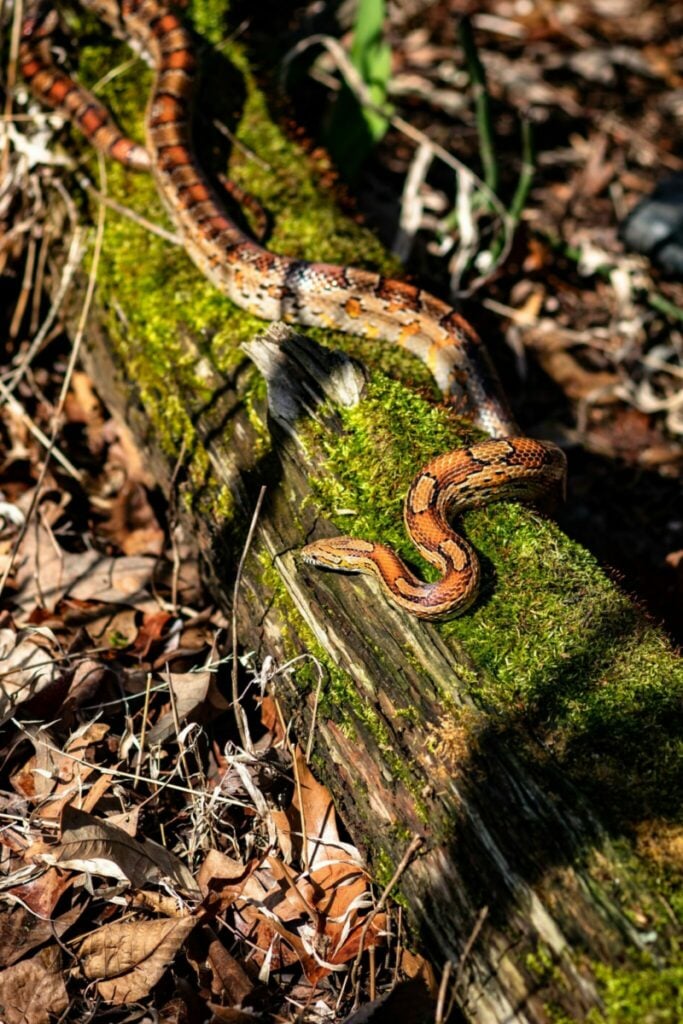
Chicken Snake Vs. Rat Snake
The five snake species categorized as “chicken snakes” are also known as “rat snakes.” The chicken snake itself is a type of rat snake. It is also known as the “tiger rat snake” and the “yellow rat snake.”
However, it differs from other rat snakes in a variety of ways. Some of these rat snakes mate and give birth to hybrids. The distribution of the gray rat snake overlaps that of the eastern rat snake.
Chicken Snake Vs. Copperheads
Copperheads and chicken snakes have very different features. Chicken snakes are much larger and heavier than copperheads. The average copperhead length ranges from 20 to 37 inches., while chicken snakes range from 48 to 96 inches – nearly double the length of copperheads.
The coppery heads of copperheads make them easy to recognize. They also differ greatly in that copperheads are venomous. On the other hand, chicken snakes are constrictors and not poisonous.
Chicken Snake Vs. Coachwhip Snake
Coachwhip snakes have long, thin tails that taper into a black head. These snakes’ color gradient depends on the environment they live in. In contrast, chicken snakes have four stripes running the length of their bodies.
Typically chicken snakes can reach a maximum length of seven feet, but the coachwhip snakes can reach eight feet. Chicken snakes prefer to be around water bodies, whereas coachwhips prefer to hunt on the ground in dry climates and avoid swimming. In contrast, chicken snakes are excellent swimmers.
How to Identify a Non-Venomous Chicken Snake:
Identifying venomous or non-venomous snakes might be difficult for some people. The size of a snake’s pupils is a simple way to tell if it is venomous or not. Pupils of venomous snakes have a vertical shape like cat eyes.
Round pupils that resemble a human’s eyes typically indicate that a snake is non-venomous. If attacked, a snake may bite even when it is not venomous. Whether there is poison or not doesn’t matter. Either way, snake bites are always painful and terrifying.
The Bottom Line:
| Key Points | |
| 1- | Chicken snakes are very long and slender. Their unique physical features make them distinct. |
| 2- | They are non-venomous. However, they can kill their prey by constricting it. |
| 3- | Some chicken snakes enlarge their necks in response to danger. It makes them look bigger. |
| 4- | Chicken snakes can climb trees and walls. Moreover, they are excellent swimmers. |
| 5- | Sometimes, farmers use them to protect their crops from rodents and other small animals. |
| 6- | Chicken snakes can be great pets, but it requires proper care and caution. |
Chicken snakes are a type of non-venomous colubrid snake and constitute five sub-species. They can be spotted throughout North America. All of these share one significant feature: they all enjoy eating young chicks and chicken eggs. You can easily differentiate them depending on their habitat.
This snake can grow to be more than 7 feet long. No matter how large it grows, a chicken snake is not poisonous. However, they are categorized as non-venomous constrictors. It means that they squeeze their prey to death before consuming it. It occasionally benefits farmers by preying on rats and small rodents.
Thank you for reading this article! If you enjoyed reading about this sneaky reptile you will probably also enjoy our post on the King Cobra vs Coral Snake.
- The Most Adorable Footage of Baby Wolves in Minnesota - April 15, 2024
- Man Teaches Bald Eagle to Play Fetch - April 15, 2024
- Mother Buffalo Tries to Save Baby From Komodo Dragons - April 14, 2024

